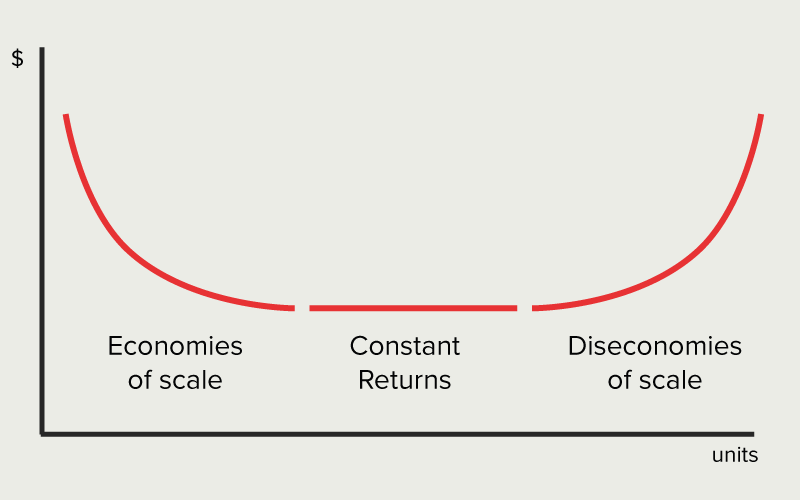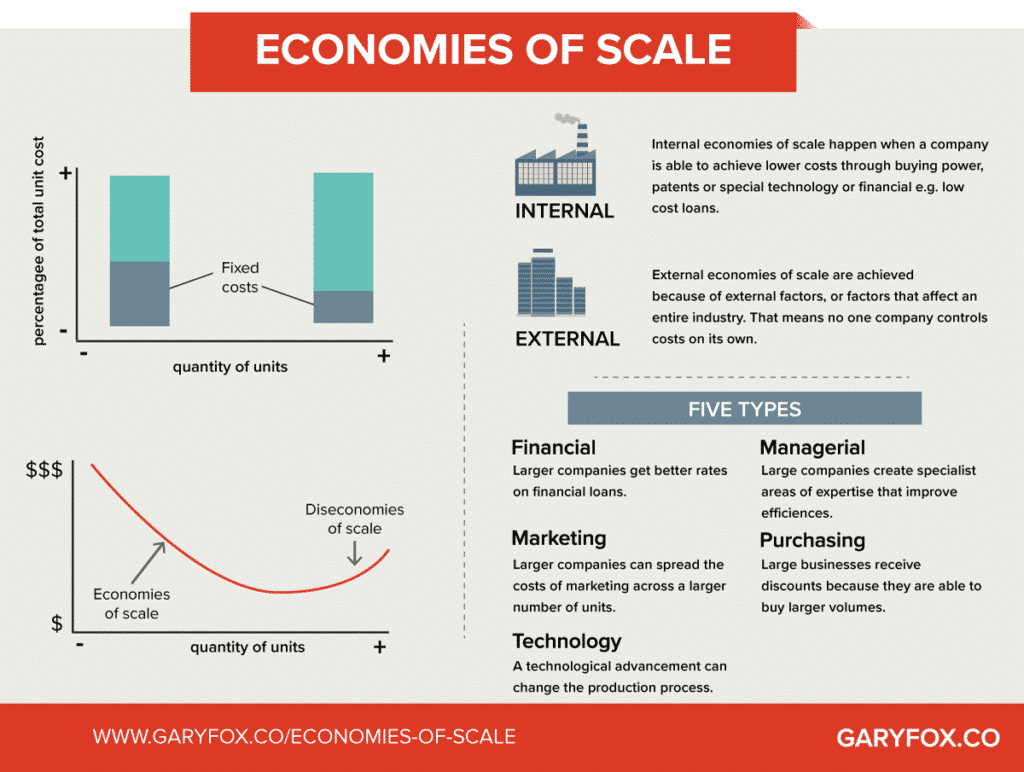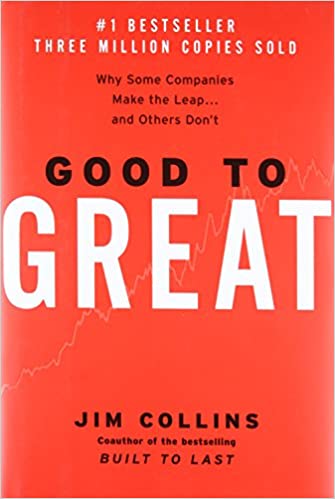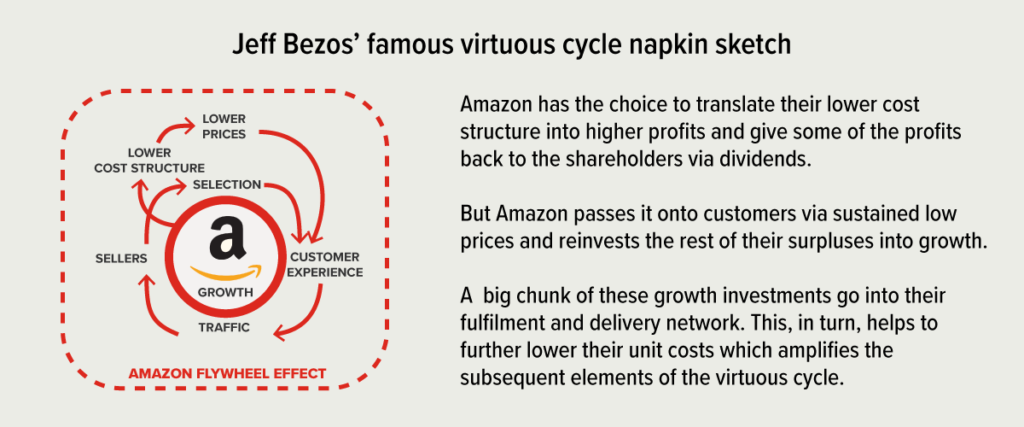Economies of scale are the reasons that larger companies have a competitive advantage of smaller companies. As an example, Walmart has a defensible competitive position (an economic ‘moat‘) because of its scale.
Walmart is able to leverage its scale to:
- Buy products at a lower price than competitors. Walmart can distribute and sell high volumes of a product compared to its competitors.
- Walmart has a highly efficient supply chain which results in lower distribution costs per unit. As a simple example, it can always fill the trucks which make the distribution costs per unit low.
- Walmart embraced and invested in technology to become an innovator in the way stores track inventory and restock their shelves, thus allowing them to cut costs. In 2015, the company spent a reported $10.5 billion on information technology. Smaller companies could never afford that level of investment in technology.

A simple explanation, imagine for a moment that you produce and sell homemade salsa in jars. As a small business, you’re limited by your time. Let’s say that in a single day you can only produce 100 jars of salsa.
Now imagine that a friend joined your business and so two of you could now make salsa.
If you:
- achieve more than 200 units a day you will have succeeded in realizing economies of scale.
- if you produce less than 200 units per day then you have incurred diseconomies of scale.
- if you simply double production and achieve just 200 units per day then you achieve constant returns.
Table of Contents
Economies of Scale Quick Explanation
Economies of Scale Key Points
- Economies of scale occur as a company’s production increases and results in fixed costs becoming a lower percentage of each unit.
- Internal economies of scale can be because of technical improvements, managerial efficiency, financial ability, monopsony power, or access to large networks.
- External economies are ones where companies can influence economic priorities, often leading to preferential treatment by governments.
- Diseconomies of scale can occur when a company becomes too big, lowering its production.
Economies of Scale Definition
An economy of scale is achieved when increasing the scale of production decreases long-term average costs.
In other words, the cost of production per unit decreases as a company produces more units. Reducing the cost per unit of production is the major advantage companies seek when scaling.

Digital Technologies and Zero Marginal Cost
Producing, distributing and selling music used to belong in the physical world. Music would be ‘burned’ onto CD’s in a factory, boxed and then distributed to stores to be sold.
Apple with iTunes changed the music industry. Music became a digital product that could be distributed almost instantly across the globe and very low cost.
The production costs of copying a file are near zero and so huge costs were eliminated as people transitioned to digital music players.
The cost of producing the first piece of music is high but then the cost of producing more digital copies is very low.
In economics, the marginal cost of production is the change in the total production cost of producing an additional unit.
Marginal costs are calculated by dividing the change in production costs by the change in quantity produced. This then determines at what point an organization can achieve economies of scale which optimize production. If the marginal cost of producing one additional unit is lower than the per-unit price, the producer has the potential to gain a profit.
Network economies of scale occur primarily in online businesses. It costs almost nothing to support each additional customer with existing infrastructure. See network effects.
So, revenue from new customers is highly profitable. A great example is eBay.
The Flywheel Effect
Jim Collins in his book Good to Great identified eight common traits that “good to great” companies share.
In creating a good-to-great transformation, there is no single defining action, no grand program, no single killer innovation, no solitary lucky break, no miracle moment. Rather, it feels like a giant, heavy flywheel. Pushing with great effort, you get the flywheel to inch forward. You keep pushing and with persistent effort, you get the flywheel to complete one entire turn. You don’t stop. You keep pushing. The flywheel moves a bit faster. The flywheel moves a bit faster. Two turns…then four…then eight…the flywheel builds momentum. Sixteen…thirty-two…moving faster…a thousand…ten thousand…a hundred thousand. Then at some stage – breakthrough! The flywheel flies forward with almost unstoppable momentum.
Jim Collins

Amazon is another company that has built a competitive advantage through the scale of its operations – both physically and digitally. The Amazon business model uses this scale to its be able to distribute products at low prices.

The Main types of external economies of scale
There are main types of economies of scale:
- Financial.
- Managerial.
- Technical.
- Marketing
- Information.
Internal Economies of Scale
Internal economies of scale offer greater competitive advantages than external economies of scale.
This is because an external economy of scale tends to be used by competitors as well. As an example, cloud technologies for music streaming are available to Apple, Google as well as Spotify.
However, it’s important to remember some companies may be in a better position to take advantage of external economies of scale than others.
For these reasons, internal economies of scale offer a greater chance of developing a competitive advantage.
Examples of external economies of scale
Transportation
Often governments make investments in infrastructure that allows multiple companies to take advantage of external economies of scale. This is done to improve overall national productivity and compete on a global scale.
As an example, investments in improved rail and road systems yield deliver more efficient transportation and thus reduce costs for businesses that use these.
Skilled labour
High concentrations of skilled labour often result from industrial clusters of companies with a specific sector. In the UK there is a large concentration of car manufacturers and engineers in the midlands area as a result of formula 1 racing and historical production facilities.
Another example is Silicon Valley, where there are large numbers of programmers because of the presence of large tech firms like Apple and Google.
The five types of economies of scale
Technology
Technical economies of scale result from efficiencies in the production process itself such as the introduction of robotics. As a result, manufacturing costs fall 70% to 90% every time the business doubles its output.
Larger companies can invest in costly technologies that are then spread across a much larger volume of production.
For example, large companies can harness expensive AI software to improve customer acquisition. Similarly, large companies such as Amazon and Walmart use technologies to improve supply chains.
Large-scale businesses can afford to invest in specialist machinery or technologies. For example, Walmart can use specialist technologies to improve planning and stock control.
The law of increased dimensions also known as the container principle offers large companies economies in scale in transportation. As an example, if you double the height and width of a tanker the cubic capacity disproportionate.
The result of this law in economies of scale in distribution, freight industries, travel and leisure sectors e.g such super cruisers such as P&O’s Ventura, super-tankers such as the Maersk ‘Triple-E’ container ship and the Airbus 280.
Research and Development Economies are rarely affordable for smaller companies. Research and development is costly and mainly limited to large scale companies e.g. pharmaceutical companies.
Purchasing Power
Monopsony power occurs when a company can reduce its per-unit costs because if its huge buying power.
Large food retailers have monopsony power and hence purchase supplies from farmers and wine growers and in completing supply contracts from food processing businesses.
Amazon uses its purchasing power in the publishing industry to get large reductions in prices it pays publishers for the books sold on the Amazon web site.
Other examples of the use of monopsony power include the prices paid by coffee roasters and other middlemen to coffee producers in some of the poorest countries.
Managerial
Economies of scale occur when large firms can afford to create specialist departments as well as hire specialists. Specialist departments enable more efficient running of operations across the company.
This is known as division of labour where firms employ specialists to supervise production systems.
Specialization of the workforce: Larger firms can split the production processes into separate tasks to boost productivity.
Improved management and the use of specialist equipment results in greater productivity and a reduction in unit costs. Workers in larger-scale factories and other such production operations can do more precise, specific jobs.
Financial
Financial economies of scale usually result from a company having access to cheaper capital.
Large companies are usually rated as being more ‘credit worthy’ and have access to credit with favourable rates of borrowing.
Often large companies get funds from an initial public offering. Moreover, large companies once listed on stock markets can raise further money by selling equity.
Marketing Economies of Scale
Marketing economies of scale result from lower costs per unit for advertising and promotion.
As production increases, firms can spread (fixed) marketing costs over a larger output. This then reduces the per-unit costs.
Additionally, larger companies benefit from greater reach and word of mouth as the critical mass increases. In other words, it forms a multiplier effect.
Economies of Scale Versus Economies of Scope
Economies of scope occur when a company branches out into multiple product lines.
They benefit by combining complementary business functions, product lines, or manufacturing processes.
For example, most newspapers diversified into similar product lines, such as magazines and online news. This diversified their revenue away from declining newspaper sales. Their advertising sales teams could sell ads in all three product lines.


